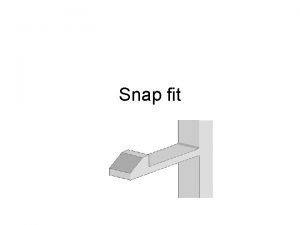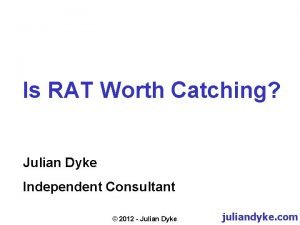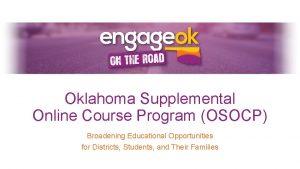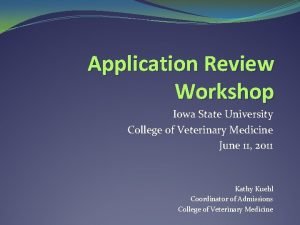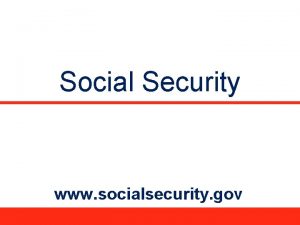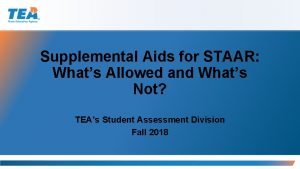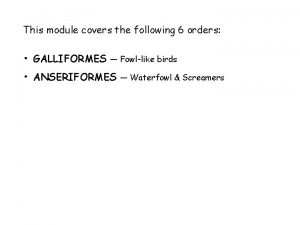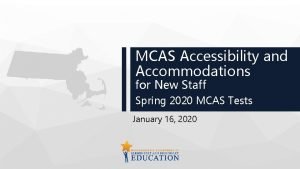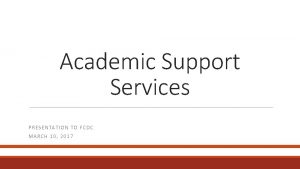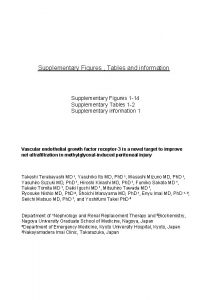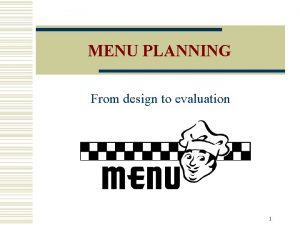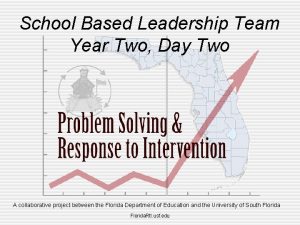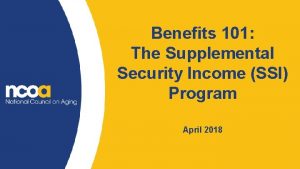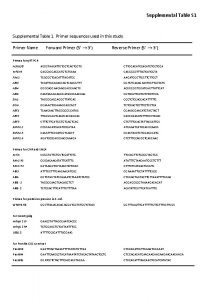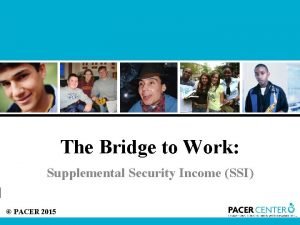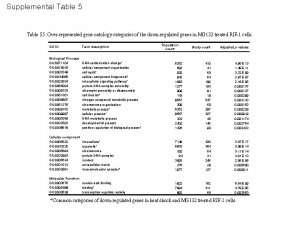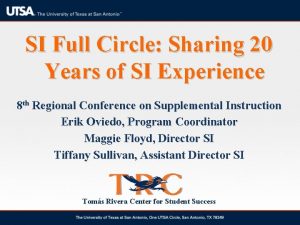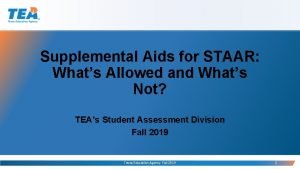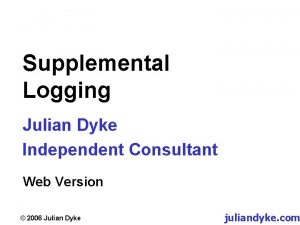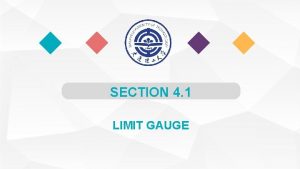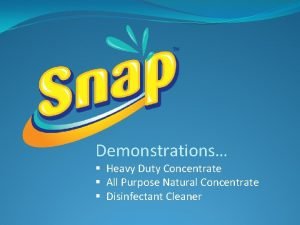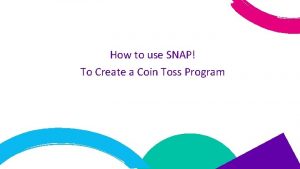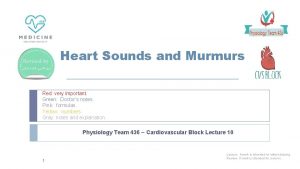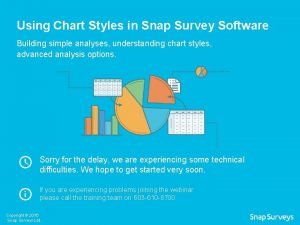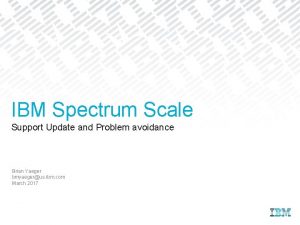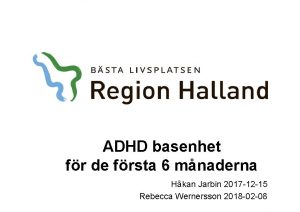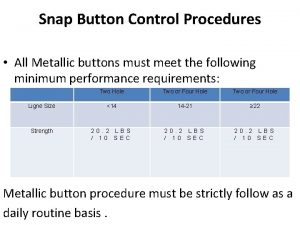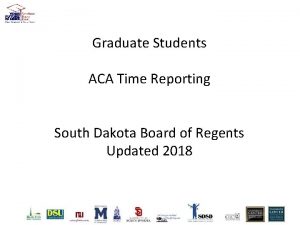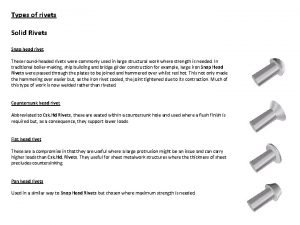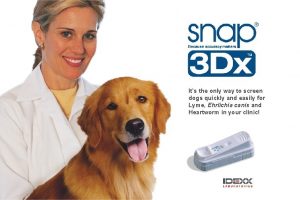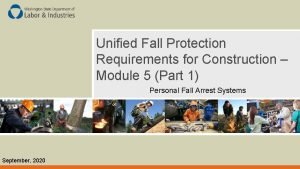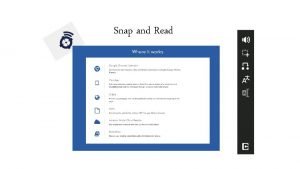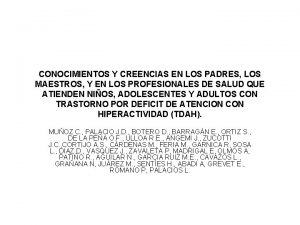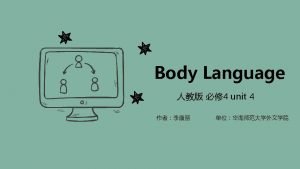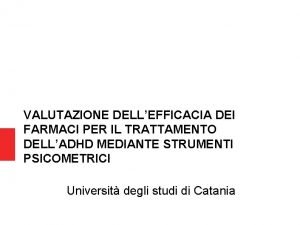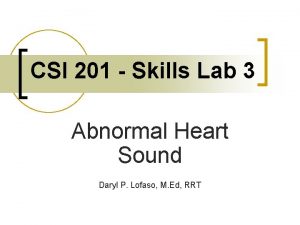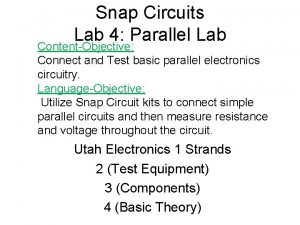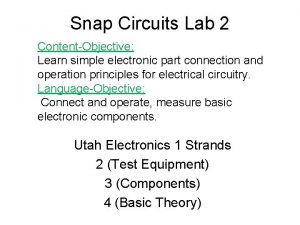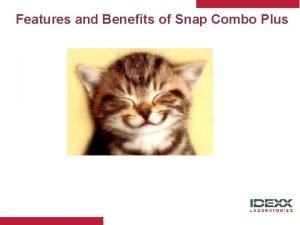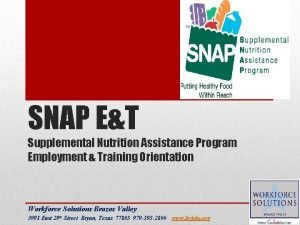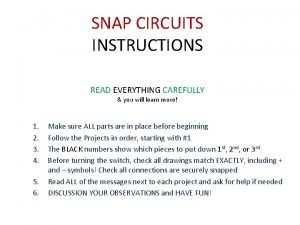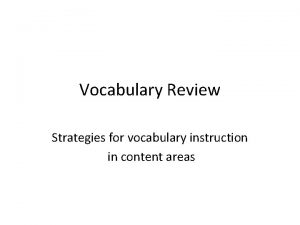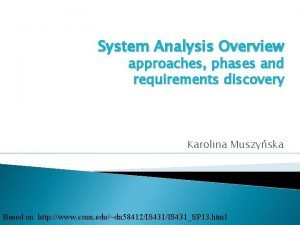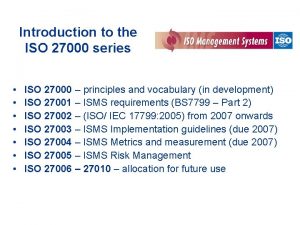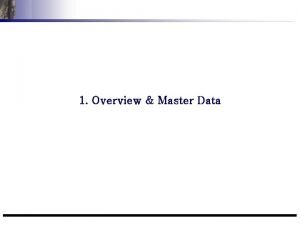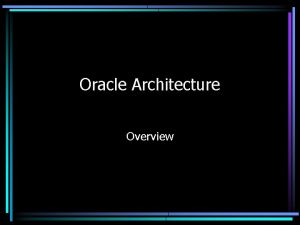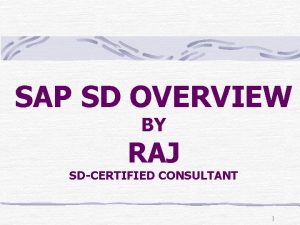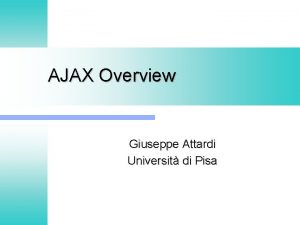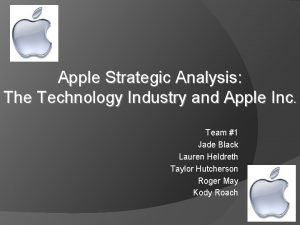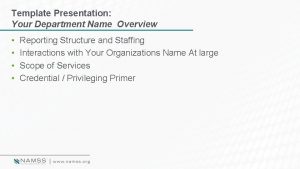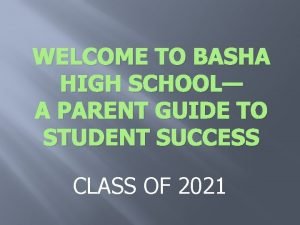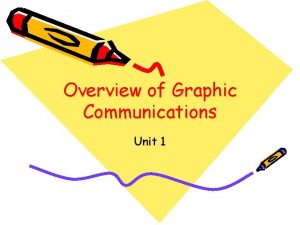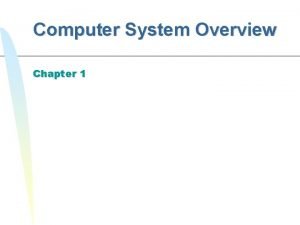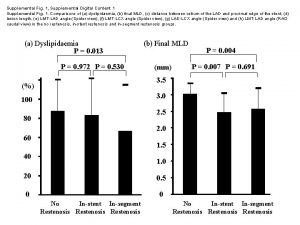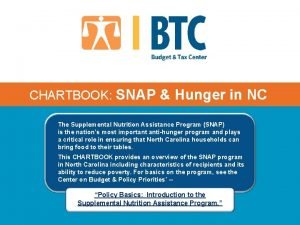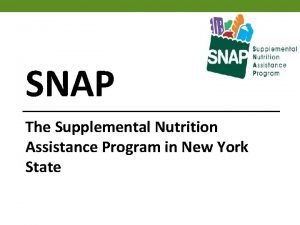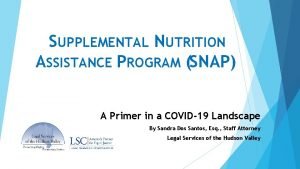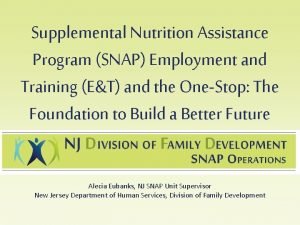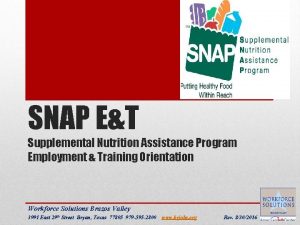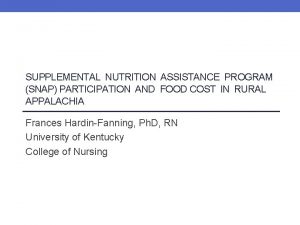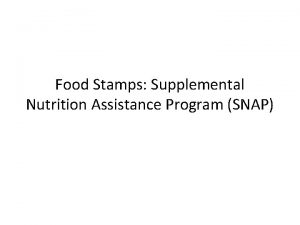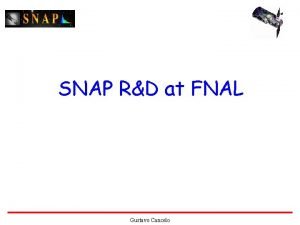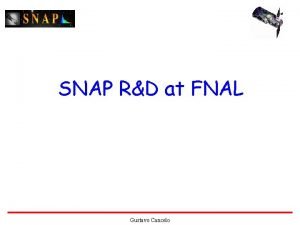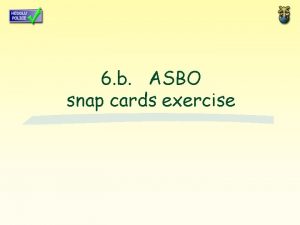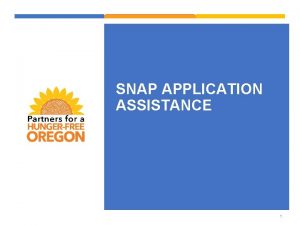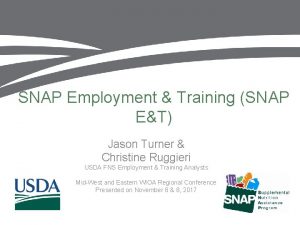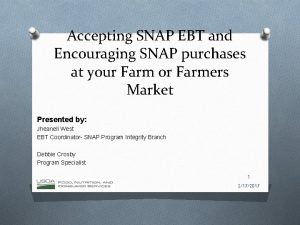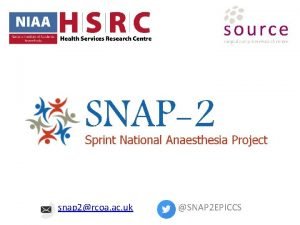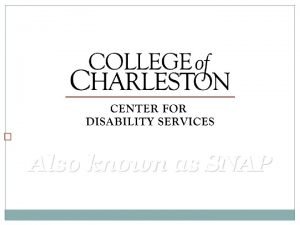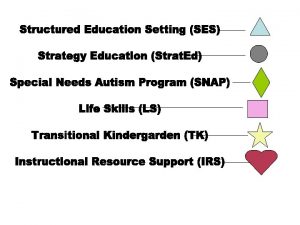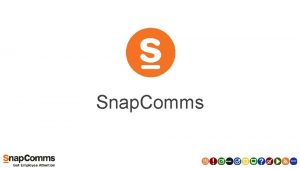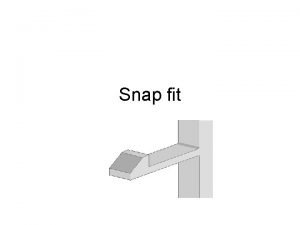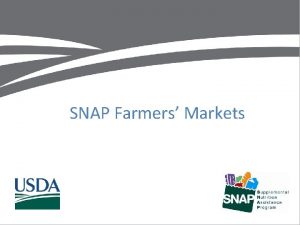SNAP 101 An Overview of the Supplemental Nutrition
































































































































- Slides: 128

SNAP 101 An Overview of the Supplemental Nutrition Assistance Program for new NOEP Coordinators


Presenters Colleen Donovan, SNAP Technical Assistance Specialist Diana Lezette, Trainer

Agenda: • Introductions • Households and Cases • The SNAP Application and Timeframes • Income and Resources • The SNAP Interview • Non-Citizen Households • Income Deductions and Expenses • Work Rules • Verification and Documentation • The EBT Card • Post-Determination • Skills Practice Yes, we will have breaks!

Goals: • NOEP Coordinators will be prepared to continue learning about SNAP and other federal nutrition assistance programs. • NOEP Coordinators will begin building a strong, open working relationship with Hunger Solutions New York staff and feel that their work is honored and appreciated. • NOEP Coordinators will recognize and engage with the resources and supports available to them from Hunger Solutions New York, including the SNAP technical Assistance Specialist and Contract Managers. • NOEP Coordinators will be prepared to increase their capacity to connect community members to SNAP and other federal nutrition assistance programs and produce results that are important to them and to the community members they assist.

Objectives After this training the NOEP Coordinator will be able to: • Identify which individuals must be included on a SNAP case. • Recognize complex cases where special circumstance might apply. • Contact appropriate resources for assistance with complex cases. • Explain the timeframe for determination and issuance of SNAP • • benefits. Identify appropriate guidelines to use for prescreen budgeting. Apply appropriate guidelines during prescreen budgeting. Correctly complete a prescreen budget worksheet based on information provided by the client. Determine correct estimated SNAP benefit allotment based on information provided by client.

Objectives • Determine which Non-citizens will be eligible to apply for SNAP. • Identify appropriate income deductions for each case. • Calculate appropriate deductions for each case. • Assist clients with identifying and obtaining documents for identification and verification. • Explain procedure for using EBT card. • Explain proper use of EBT card and items eligible for purchase with EBT card. • Identify post-SNAP application determination actions that may be undertaken by NOEP Coordinators (ex. Assist with recertification, direct clients to legal assistance for Fair Hearing).

Households or Cases

For SNAP purposes there can be more than one SNAP “Household” living under the same roof.

Types of Households/Cases • Mandatory Hhs (Households) • Separate Voluntary Hhs • Special Household Arrangements • Other Unique Hh Arrangements (ex. Homeless) • Invisible and Non-Invisible Members

Mandatory Households/Cases • Married and living together • Children under 22 and living with parent(s) • Children under 18 under parental control by an adult • Those who buy and prepare food together

Married + living together = mandatory on one case

Separate VOLUNTARY Hhs/Cases Live together but do not buy and prepare food together • Ex. distant relatives, friends, roommates, non-married couples without children

Separate Voluntary Hhs/Cases David Kelly $194 $388 $357

Angela, 25 yrs. old, works part- time, lives with parents, buys and prepares her own food. Yes, she can apply separately. See: Household Composition Handout

Boarders – Room and Meals Not a part of the household, but may be considered to be a member of the household at the household’s request. See: Appendix M – Supplemental Nutrition Assistance Program in New York State: An Eligibility Prescreening Guide, Hunger Solutions New York, Oct. 2015 Edition.

Roomers – Room, No Meals Not considered a part of the household, but may apply as a separate household. See: Appendix M

Shared Living – Pays a share of Shelter Expenses Not considered a part of the household, but may apply as a separate household. See: Appendix M

Foster Care Children Foster care children – Hh has option to include or exclude on the case. Foster care grants – if Hh receives a foster care grant it is included in Hh income if the child is on the case.

Homelessness Do not need a permanent address to apply. Who is included in the case? Ex. Temporarily staying with friends, family, homeless shelter

Severely Disabled People Living with Others • Person cannot buy and prepare his/her meals. • May still apply for SNAP as a Hh of 1 if: • The person’s food is bought and prepared separately or: • Not purchased and prepared separately but the person is elderly and disabled and the housemate(s) income does not exceed 165% of poverty.

Ineligible Students must meet certain rules to qualify for SNAP. Ineligible students are not counted as a part of a SNAP case and their income and resources are not counted.

Married ineligible student and wife See: Prescreening Guide Appendix L

Example: • Married couple • Wife applying for SNAP • Husband is not working • Husband is College Student – does not meet exceptions for college student to apply • Household number decreases See: Prescreening Guide – Appendix L

Non-Citizen SNAP Ineligible Parents

Non-Citizen Mom and Dad: Example • Mom and Dad not eligible for SNAP due to Non-citizen Rules. • Two kids, both born in US and so are citizens. • Mom and Dad can apply for SNAP on behalf of kids. • Family size = 2 • Parents income prorated.

Intentional Program Violation and Sanctions (IPV)

Intentional Program Violation and Sanctions: Example: • Sanctioned single father • Two children • Dad applies for SNAP • Dad’s entire income and resources counted • Dad is not eligible • Case budget will be for a family of 2

Timeframes Expedited and Regular Application Processing

Prescreening Guide: Appendix D

SNAP Application • Applications processed based on submission date. • Must be accepted by DSS/HRA if it has: • Name • Address (if there is one) • Signature on Page 1 Signature on page 5 of SNAP Application must be provided eventually

SNAP Application Can be submitted: • Online (My. Benefits or Access. NYC) • In-person • By Mail (In NYC – MARU) • By Community Agency including NOEP • By Fax (NYC Right Fax Numbers) • Easy Access Sites - NYC Facilitated In-take Locations

SNAP Application Processing Timeframes Application Submission Date Expedited Within 5 Days Determination by LDSS or HRA Regular Determination by LDSS or HRA Within 30 Days

Expedited Processing Eligible for Expedited Processing if any one of the following: • Less than $100. 00 in liquid resources and less than $150. 00 gross income for the calendar month or • Shelter costs greater than liquid resources and gross income for the calendar month or • Migrant or seasonal worker and liquid resources less than $100. 00 and SNAP definition of destitute.

Eligible for Expedited • Screened by LDSS/HRA when submitted – caution against saying your client is eligible for expedited. • Processed within 5 days. • Only verification needed for expedited benefits processing: Identification • ID Card, confirmation by friend, relative, etc. • LDSS/HRA must assist in getting ID verified if person has no ID card.


Collateral Contact: Definition A verbal confirmation from a person, other than the SNAP applicants, that can verify applicants’ circumstances and or/identity. Examples: Other caseworker confirms ID, landlord confirms residency, friend confirms applicant is staying with them short term and buys own food.

Prescreening Guide, Appendix E

Expedited to Ongoing For benefits to continue more documentation will be needed within 10 days.

Applicant is applying again, and again is eligible for expedited processing, but did not submit needed documentation for ongoing last time: • Special Rule: If a client previously received Expedited SNAP but did not submit documentation for ongoing benefits they will need to submit missing information or all information that is required for new application.

NYSNIP • NYSNIP is the New York State Nutrition Improvement Project. • Auto enrollment in SNAP for SSI recipients who live alone. • NYSNIP benefits start within two months of receiving SSI. • Benefits are standardized based on housing costs and utility costs. • NYSNIP Matrix is updated regularly to reflect new benefit amounts.


Income Types

Income Types • Earned: Ex: gross wages, selfemployment earnings • Unearned: Ex: Social Security, SSI, court-ordered child support • Exempt: Ex: income tax returns, EITC tax credits, HEAP Payments • No Income

See: Page 37 – Prescreening Guide

See: Page 38 – Prescreening Guide

Military Income

Military Income • Military Pay (often pay plus allowances) • Many military acronyms and terms (ex. BAH, BAS) • Find resources – “military translators”: • Clients • Veterans groups • A resource person at DSS/HRA • Become a resource for other NOEP Coordinators.

Income Guidelines

What Guidelines do I use? 130% - Most cases 200% - Households with at least one: • Senior – (60 or older) • Disabled – (Receiving federally related disability benefits ex. SSD) • Dependent care costs See: SSI/SSD Handout

Elderly and Disabled Definitions For SNAP purposes: • Elderly means 60 or older. • “Disabled” means receiving federally related disability benefits such as: • SSI • SSD • Disability-related Medicaid • VA Disability 100% See: Prescreening Guide: p. 36

Income Eligibility Guidelines What Guidelines do I use? Family Size 130% of Poverty Monthly Income 200% of Poverty Monthly Income 1 $1, 276 $1, 962 2 $1, 726 $2, 655 3 $2, 177 $3, 348

Dependent Care Costs – Adult or Child Daycare • Use daycare costs as a deduction in the budget. • Adult family members (caregivers) must be employed, looking for work, in employment or training program.

Categorical Eligibility • Most Hhs applying for SNAP will be categorically eligible. • No resource limit. • If categorically eligible, can exceed net income limit. – see Budget Worksheet Line 18 (also Appendix K)

Households Where Income and Net Resources Must Be Considered 1. Cases/Hhs with Senior or Disabled Member and Gross Income (Before Deductions) is over 200% FPL. 2. Cases/Hhs with member(s) who have IPV (Intentional Program Violation) or other sanction and under 130% of FPL. $3, 250 Resource Limit $2, 250 Resource Limit

0 1 200% FPL 130% FPL No Resource Test/No Net Income Test Hh with no senior/disabled member and no child or dependent care (daycare) expenses Not SNAP Eligible No Resource Test/No Net Income Test 2 Hh with no senior/disabled member , but with child or dependent care expenses Not SNAP Eligible No Resource Test/No Net Income Test 3 Hh with a senior/disabled member See: Appendix J for more info. Resource Test & Net Income Test Required

A Reminder: Only Cases/Hhs with a Senior or Disabled member can be eligible when they are over income.

Resources § Everyone is asked about resources on the application (Page 3 of application). § Prescreening Guide has examples of countable and exempt resources. § Most Hhs/Cases will not need to count resources. See: Prescreening Guide pgs. 34 -35 and SNAP Application pg. 3

Resources Countable Resources include: cash on hand, money in the bank, stocks, bonds, IRAs. Exempt Resources include: one vehicle for each adult on the case, life insurance, one burial plot person.

The SNAP Interview An Overview

Interview Basics All SNAP applicants interviewed: in-person or phone. § At time of application or soon as possible. Expedited SNAP eligible – within 5 days of application submission. § May take anyone applicant wishes to have at interview including legal representation. § Always have a right to request a face-to-face interview. §

Interview Basics o. All SNAP applicants interviewed: in-person or phone Reminder: NOEP Coordinators cannot be o. At time of application or soon as possible. Authorized Representatives and cannot Expedited SNAP eligible – within 5 days of attend the interview (in-person or phone) application submission in lieu of the client. Client must be present. o. May take anyone applicant wishes to have at interview including legal representation

What is Covered Application reviewed § Clarifying questions § Additional questions re: resources, income, expenses, etc. § Deadline for submission of any needed documents or verification. At least 10 days given. §

Phone Interviews Phone interviews granted for: § Working Families § Seniors/Disabled § Those who apply online or using MARU § Others may be granted by request (Waived by LDSS) § May waive office interview for Recertification

Missed Interviews Letter: Notice of Missed Interview (NOMI) § If applicant does not reschedule case will be denied. § Denial letter sent § See: SNAP Interview Handout

Non-Citizen Households

To Be Eligible for SNAP The non-citizen must: 1. Have Qualified Alien Status. and 2. Meet a condition that allows non-citizens to receive SNAP.

Undocumented non-citizens can NEVER receive SNAP

Qualified Alien Status Examples: • Lawful Permanent Residents (LPRs or “green card” holders) • Refugees • Asylees • Amerasian Immigrants • Certain Domestic Violence survivors

Which Qualified Non-Citizens can receive SNAP? Examples: • Children under 18 with qualified alien status • Disabled persons with qualified alien status • Adults who have held qualified alien status for at least 5 years • Refugees (now including Afghan and Iraqi Special Immigrants)

Other Qualified Non-Citizens who can receive SNAP: LPRs* with Substantial work history: 40 Quarters Test 3 months of work at a minimum salary = 1 Work Quarter *LPRs = Lawful Permanent Residents

For more on Non-Citizens See: Prescreening Guide Appendix H and Pages 24 -26.

Citizen and Non-Citizen Hhs/Cases • At least one person must be citizen or Qualified Non-Citizen. • Only Citizen or Qualified Non-Citizen in the Hh will receive SNAP.

Citizen and Non-Citizen Hhs/Cases: Example • SNAP ineligible Non-citizen parents and child born in the US so the child is a citizen. • Child is eligible for SNAP. • SNAP case is only for the child. • Parents are listed on application.

Public Charge • USCIS has made it clear – participation in SNAP does not make a person a public charge. • SNAP office only need report persons known to be unlawfully present in US. • In NYS SNAP office to report only if person shows a final order of deportation or has falsified documents. Report is to OTDA not USCIS.

Sponsor Deeming • Affidavit of Support • Accept legal financial responsibility for another person who is coming to the US • If sponsored non-citizen is eligible, the income of a sponsor who does not live in the household can be counted in some cases. See: pp. 46 -47 Prescreening Guide

Liability Rule: SNAP benefits provided to a sponsored non-citizen may be recouped from a sponsor. OTDA (NYS) will not pursue legal action even though DSS may request reimbursement. Call Colleen for guidance

Income Deductions and Expenses

Calculating Income Paid Earned Income Gross Income (before deductions) Weekly x 4. 33 • Ex. $600 x 4. 33 = $2598 Bi-Weekly x 2. 17 • Ex. $1200 x 2. 17 = $2604

Monthly Income: Senior or Disabled SS, SSI, SSD no calculation necessary but still use gross income – medical deductions discussed soon.

Deductions: Child Support Paid • On Budget Worksheet – 1 st item that can be deducted. • Only legally obligated payment can be deducted, including: • Insurance payments for children • Arrears payments

Earned Income Deduction • Only Earned Income is eligible for Earned Income Deduction • Monthly Gross Income x 20% • Ex. $800 x. 20 = $160. 00

Standard Deduction Standard amount deducted for each case/Hh – based on family size. Standard Deduction Amounts Household Size Deduction 1 -3 4 5 6+ $155 $168 $197 $226

Child and Dependent Care Deduction • Ask about Child Care Costs. • Ask about Dependent Care Costs (Adult Day Care). • Full cost can be deducted if there is no caregiver available due to work, school, looking for work.

Homeless Shelter Deduction of $143. 00 per household can be taken if: • No permanent, fixed housing • Not paying any shelter costs, including utilities

Medical Deductions • Seniors (Over 60) • SNAP definition of Disabled • Can deduct full costs of out of pocket medical expenses after the first $35 per month • Examples: health insurance premiums, eyeglasses, co-pays, unpaid medical bills, hearing aids, and more See: SNAP Deduction Handout and Page 41 Prescreening Guide

Citizen and Non-Citizen Hhs/Cases. Example: 1. Divide the ineligible person’s income by the number of people on the application 2. Multiply the result by the number of people who are eligible for SNAP (Income/# of people) x # of people in the SNAP case

Citizen and Non-Citizen Hhs/Cases: Example: Prorating Ineligible Parent’s Income $500. 00 / Number of People on the application 3 X Number of Eligible Hh Members 1 = Income is $166. 66 and family size is 1

Citizen and Non-Citizen Hhs/Cases: Example: 2 Parents, 1 child No Proration Eligible Parent’s Income $500. 00 Ineligible Parent Has No Income = Income is $500. 00 and family size is 2

Citizen and Non-Citizen Hhs/Cases: Example: Prorating with 1 Parent a Citizen and Child Citizen Ineligible Parent’s Income $250. 00 / Number of People on the application 3 X = Number of Eligible Hh Members 2 Income for the Hh with two on the case $416. 66 = Income is $166. 66 + Income of Eligible Parent $250. 00

Budgeting Eligible and Non-Eligible Expenses and Resources: Some other household expenses must also be prorated such as daycare costs and shelter cost.

Prorating Shelter: Example: • Eligible Mom pays rent – the entire cost of rent is counted in budgeting • Ineligible parent paying rent, other parent no income – rent is prorated: • Rent is $500. 00 and paid by ineligible parent, $500 divided by 3 (people in Hh) multiplied by 2 (Eligible applicants) = $333. 33 and budgeted as a family of two.

Resources and SUA (Standard Utility Allowance) are never prorated

Housing Costs Shelter costs can include: • Rent, Mortgage, Property and school taxes, car payments for homeless and living in car, and more. • Shared living: portion of the rent actually paid by applicant counted. • Internet, cable, car insurance, etc. not counted.

Standard Utility Allowance • SNAP Hhs in NYS may receive one of three allowances based on: • Type of Housing • Location in the State • SUA, not actual utility costs, used in SNAP budgeting. • SUA is never prorated. See: SUA Worksheet Handout

Excess Shelter Deduction • A deduction from Hh income because it is assumed people will have shelter costs that can’t be used for food. • Formula for calculating deduction but capped at $504. 00 except for Hhs with senior or disabled person. • Actual amount used for senior or disabled Hhs.

Net Income If the Household is Not Categorically Eligible then net income amount must be less than 100% Federal Poverty Level.

Thrifty Food Plan • A way to measure meeting basic food needs at lowest cost. • Maximum SNAP benefit based on Thrifty Food Plan. • Most households do not qualify for maximum.

Thrifty Food Plan H. H. Size Maximum Allotment 1 2 3 Maximum Allotment $194 $357 $511 4 5 6 7 $649 $771 $925 $1, 022 $1, 169 +$146 Maximum SNAP (Thrifty Food Plan) ALLOTMENTS by household size (October 1, 2015– September 30, 2016): 8 Each Additional Person

SNAP Minimum benefit is based on the Thrifty Food Plan: 1 -2 person households • Minimum benefit for all 1 -2 person household who are categorically eligible (or who are below net income) is $16. • If the estimated benefit is less than $16, these types of households will be eligible for $16. • The minimum benefit can be issued for these types of cases even if the estimated benefit is zero or a negative number.

SNAP Minimum benefit is based on the Thrifty Food Plan: Households with 3 or more people • Households with 3 or more people are not guaranteed the $16 minimum benefit. • When these households have an estimated benefit of zero or a negative number, they are not eligible for a SNAP benefit.

Documentation and Verification üFull list in Prescreen Guide. üAny reasonable form of documentation must be accepted and not limited to a specific document. üIf applicant cannot get documentation for example a Birth certificate – caseworker must assist and DSS must pay fee. See: Appendix F and G

Computer Matches, DSS Info Access DSS/HRA has access to some information from other public programs, government agencies and some banks. Ex: IRS, Social Security Admin. , DMV, Tax and Finance This access lets DSS/HRA verify or locate information for eligibility determination for SNAP.

Authorized Representative Someone designated by the SNAP applicant/recipient to: • Apply on the client’s behalf • Recertify for benefits • Use the EBT card Form exists to designate an Authorized Representative • Cannot be NOEP Coordinator

Work Rules • Work assignments, enforcement and requirements may vary. • Many people are exempt from the work rules. • Work activities are assigned and enforced when receiving benefits, not at application start. • New rule states that SNAP offices must grant SNAP recipients an option to show compliance before issuing a sanction. See: SNAP Policy Memo #9, January 22, 2015 for more information

ABAWDs – Able Bodied Adults without Dependents • A person between the ages of 18 and 49 years old, who is not disabled, and who lives in a SNAP household without any children under 18. • ABAWDS are subject to additional work rules.

ABAWDs • ABAWDS can only receive SNAP for three months in three years unless they meet work criteria or an exemption. • Clock started Jan. 1, 2016

ABAWDs • Many counties, some areas, of NYS have waivers • This is a reinstatement of a rule that had been in place.

ABAWDs Exemptions: • Under 18 or over 50 years old • Pregnant • Physically or mentally unfit to work 20 hours or more per week • Residing in a SNAP household that contains a child under 18 years old

ABAWDs NOEP Work: • Ask additional questions during prescreen: ex. Age and number of hours working. • Assist those who have been deemed ABAWD but are not (ex. Help client get document that proves work).

ABAWDs NOEP Work: • Make referrals for those who are classified ABAWD. For example, to job training or food pantries. • More information: http: //hungersolutionsny. org/abawd SNAP Policy Memo #5, 12/18/15

Voluntary Quit • SNAP participant quits/reduces hours without good cause. • Only applies to those not exempt from work rules. • Valid reasons for quit include: transportation problems, child care difficulties, etc.

Sanctions and Intentional Program Violations (IPV) • Not complying with Work Rules or an Intentional Program Violation (IPV). • IPV examples: false statements, false documents, using SNAP benefits illegally. • Sanctioned person’s income and resources counted but household budgeted for one less person.

Prescreening Guide: Appendix D – SNAP Application Pg. 3 SNAP Penalty Warning

Determination Letter • Approved or Denied • Lots of information • Summary of budget and budget calculations used • Time period case is active • Any additional documents required (Expedited SNAP)

EBT Card Electronic Benefits Transfer or Common Benefits ID Card (CBIC) • Sent via mail (generally). • SNAP benefits may be put on existing benefit card (ex. Medicaid). • Benefits deposited monthly – Upstate on same day each month, NYC on a schedule.

EBT Card Use • Most foods can be purchased with SNAP. • Accepted at most large food stores and neighborhood stores/bodegas. • Accepted at many Farmers’ Markets. • No need to separate items when checking out. • Unused SNAP benefits stay on the card for 365 days. See: EBT FAQ Handout

EBT Use – SNAP Cannot be used for: • Beer, Wine, Liquor • Cigarettes, Tobacco • Non-food items ex. toiletries, cleaners, aluminum foil, garbage bags, etc. • Vitamins and medicine • Ready to eat hot meals • Prepared cold food that will be eaten in store See: EBT FAQ Handout

Replacement SNAP benefits Special rules to help households which have experienced food loss due to a household misfortune. For example: • Power Outage (4 hours or more) • Refrigerator failure • Flood • Failure to pay utility bill

Replacement SNAP benefits • Must be reported to DSS within 10 days of misfortune verbally, in-person, in writing. • Must submit signed and completed form within 10 days of reported loss (by mail or in-person). • NOEPs - Know the location, address, fax number for submitting form. See: Prescreening Guide p. 58 -59 and Appendix O

Disaster SNAP - DSNAP Most important to know: Hunger Solutions New York will let you know a Disaster SNAP program has been put into effect by the State and will give you assistance and guidance. See: Prescreening Guide p. 59

You will be prepared for SNAP Emergency Situations because you will have your NOEP Disaster Response Plan complete and up to date.

Fair Hearing §Applicant/Recipient believes DSS/HRA had made an error in their case. §Administered at State level. §Time sensitive. §NOEP Cannot attend/be part of Fair Hearing. §NOEP can try and resolve issues before resorting to fair hearing.

Change Reporting • Reporting changes (ex. Income) to DSS/HRA • 10 Day Reporters – report changes by the 10 th day of the month following the change. • 6 Month Reporters – report if income goes above 130% of poverty level. See: Appendix P

Recertification • SNAP cases may be open for 1 month to 4 years. • Must periodically recertify. • Packet mailed to address on record. • Including telephone interview time and date. • Must comply for continued benefits.


Skills Practice aka Putting It All Together

Thank You! Colleen Donovan SNAP Technical Assistance Specialist Hunger Solutions New York colleen. donovan@hungersolutionsny. org 518 -436 -8757 x. 126 Diana L. Lezette Training & Instructional Design Coordinator Hunger Solutions New York diana. lezette@hungersolutionsny. org 518 -436 -8757 x. 122 Prepared by a project of Hunger Solutions New York, USDA/FNS, and NYSOTDA. This institution is an equal opportunity provider.
 Filing snap fit snap partner maylundentechcrunch
Filing snap fit snap partner maylundentechcrunch Supplemental logging
Supplemental logging Oklahoma supplemental online course program
Oklahoma supplemental online course program Iowa state vet school supplemental application
Iowa state vet school supplemental application Ubc nursing program
Ubc nursing program What is supplemental security income
What is supplemental security income Tea supplemental aids
Tea supplemental aids Supplementary figure
Supplementary figure Galliform with supplemental molt
Galliform with supplemental molt Mcas supplemental reference sheet
Mcas supplemental reference sheet Supplemental instruction
Supplemental instruction Supplementary figures
Supplementary figures Menu planning constraints
Menu planning constraints Math supplemental aids
Math supplemental aids Supplemental instruction
Supplemental instruction Supplemental security income (ssi)
Supplemental security income (ssi) Supplementary table 1
Supplementary table 1 What is supplemental security income
What is supplemental security income Supplemental table
Supplemental table Utsa supplemental instruction
Utsa supplemental instruction Tea blank graphic organizers
Tea blank graphic organizers Supplemental instruction
Supplemental instruction Ucla mecn personal statement
Ucla mecn personal statement Alter table add supplemental log data all columns
Alter table add supplemental log data all columns Supplemental figure
Supplemental figure Supplemental table 1
Supplemental table 1 Từ ngữ thể hiện lòng nhân hậu
Từ ngữ thể hiện lòng nhân hậu Diễn thế sinh thái là
Diễn thế sinh thái là Ví dụ về giọng cùng tên
Ví dụ về giọng cùng tên 101012 bằng
101012 bằng Tỉ lệ cơ thể trẻ em
Tỉ lệ cơ thể trẻ em Chúa sống lại
Chúa sống lại Sự nuôi và dạy con của hổ
Sự nuôi và dạy con của hổ đại từ thay thế
đại từ thay thế Vẽ hình chiếu vuông góc của vật thể sau
Vẽ hình chiếu vuông góc của vật thể sau Quá trình desamine hóa có thể tạo ra
Quá trình desamine hóa có thể tạo ra Công thức tiính động năng
Công thức tiính động năng Thế nào là mạng điện lắp đặt kiểu nổi
Thế nào là mạng điện lắp đặt kiểu nổi Hình ảnh bộ gõ cơ thể búng tay
Hình ảnh bộ gõ cơ thể búng tay Lời thề hippocrates
Lời thề hippocrates Dot
Dot Vẽ hình chiếu đứng bằng cạnh của vật thể
Vẽ hình chiếu đứng bằng cạnh của vật thể Phản ứng thế ankan
Phản ứng thế ankan Các môn thể thao bắt đầu bằng tiếng chạy
Các môn thể thao bắt đầu bằng tiếng chạy Khi nào hổ mẹ dạy hổ con săn mồi
Khi nào hổ mẹ dạy hổ con săn mồi điện thế nghỉ
điện thế nghỉ Một số thể thơ truyền thống
Một số thể thơ truyền thống Biện pháp chống mỏi cơ
Biện pháp chống mỏi cơ Trời xanh đây là của chúng ta thể thơ
Trời xanh đây là của chúng ta thể thơ Voi kéo gỗ như thế nào
Voi kéo gỗ như thế nào Slidetodoc
Slidetodoc Các số nguyên tố
Các số nguyên tố Thiếu nhi thế giới liên hoan
Thiếu nhi thế giới liên hoan Phối cảnh
Phối cảnh Các châu lục và đại dương trên thế giới
Các châu lục và đại dương trên thế giới Thế nào là hệ số cao nhất
Thế nào là hệ số cao nhất Sơ đồ cơ thể người
Sơ đồ cơ thể người Tư thế ngồi viết
Tư thế ngồi viết đặc điểm cơ thể của người tối cổ
đặc điểm cơ thể của người tối cổ Cách giải mật thư tọa độ
Cách giải mật thư tọa độ Glasgow thang điểm
Glasgow thang điểm Bổ thể
Bổ thể Tư thế ngồi viết
Tư thế ngồi viết ưu thế lai là gì
ưu thế lai là gì Thẻ vin
Thẻ vin Cái miệng nó xinh thế chỉ nói điều hay thôi
Cái miệng nó xinh thế chỉ nói điều hay thôi Thơ thất ngôn tứ tuyệt đường luật
Thơ thất ngôn tứ tuyệt đường luật Các châu lục và đại dương trên thế giới
Các châu lục và đại dương trên thế giới Fungsi plug gauge
Fungsi plug gauge Snap heavy duty concentrate
Snap heavy duty concentrate Uncw ushop
Uncw ushop Coin toss
Coin toss Grading of murmer
Grading of murmer Snap surveys
Snap surveys Mmdelnode force
Mmdelnode force Snap fistula management
Snap fistula management Snap-iv bedömning
Snap-iv bedömning Action tag and dialogue tag
Action tag and dialogue tag Pinch setting for snap
Pinch setting for snap River bed cultivation of cucurbits
River bed cultivation of cucurbits What's in the backpack ares gives percy
What's in the backpack ares gives percy Scotch snap example
Scotch snap example Sdbor snap
Sdbor snap Snap head
Snap head Snap circuit lab
Snap circuit lab Metaphors in lose yourself
Metaphors in lose yourself Snap test
Snap test Dbi sala
Dbi sala Snapandread
Snapandread Share data
Share data Snap iv tdah
Snap iv tdah Happpy nod
Happpy nod Snap iv rating scale
Snap iv rating scale Csi 201
Csi 201 Snap for fistula
Snap for fistula Snap circuits project lab
Snap circuits project lab Snap circuit lab
Snap circuit lab Tronixkit
Tronixkit Snap combo plus
Snap combo plus Objectives of decision making
Objectives of decision making Mechanical fastening
Mechanical fastening Question list for snap
Question list for snap Snap circuit lab
Snap circuit lab Rotational molding advantages and disadvantages
Rotational molding advantages and disadvantages Snap-iv ålder
Snap-iv ålder Snap employment and training program texas
Snap employment and training program texas Snap circuits instructions
Snap circuits instructions Overview of cellular respiration
Overview of cellular respiration Vocabulary overview guide
Vocabulary overview guide Overview of business environment
Overview of business environment System design overview
System design overview 27000 series
27000 series Sap sd overview
Sap sd overview 2 peter overview
2 peter overview Www overview
Www overview Overview of oracle architecture
Overview of oracle architecture Sap sd overview
Sap sd overview Oedipus episode 2 summary
Oedipus episode 2 summary Ajax
Ajax Apple industry overview
Apple industry overview Department overview template
Department overview template Basha high school graduation requirements
Basha high school graduation requirements Overview of graphic communications
Overview of graphic communications Computer system overview
Computer system overview Nerolac paint price 20 litre
Nerolac paint price 20 litre Overview of personal finance chapter 1
Overview of personal finance chapter 1 Chapter 24 trauma overview
Chapter 24 trauma overview Exchange online protection overview
Exchange online protection overview Psalm 119 overview
Psalm 119 overview
